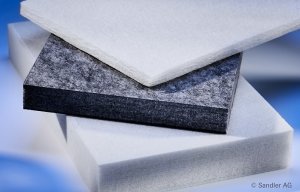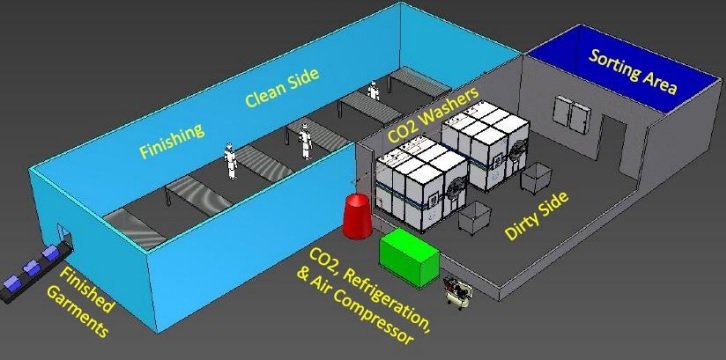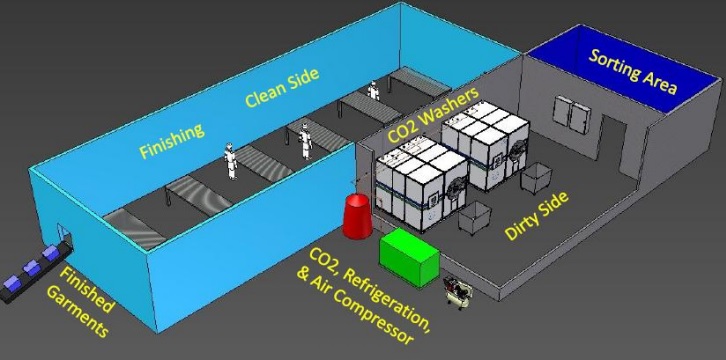
Sandler presents nonwovens for optimum comfort
According to CO2 Nexus, the producer of CO2-based textile and garment cleaning solutions, traditional cleanroom laundries and other service centres that launder textiles and garments worn in controlled environments are faced with high capital and operating costs, and create significant sustainability impacts. The company believes these costs are in large part driven by the water-based infrastructure and processing steps needed to meet cleanroom garment standards. By replacing water-based methods with liquid carbon dioxide (CO2)-based cleaning methods, operational costs, capital infrastructure, and sustainability impact can all be significantly reduced, according to the company.

27th November 2013
Innovation in Textiles
|
Denver, CO
According to CO2 Nexus, the producer of CO2-based textile and garment cleaning solutions, traditional cleanroom laundries and other service centres that launder textiles and garments worn in controlled environments are faced with high capital and operating costs, and create significant sustainability impacts.
The company believes these costs are in large part driven by the water-based infrastructure and processing steps needed to meet cleanroom garment standards.

By replacing water-based methods with liquid carbon dioxide (CO2)-based cleaning methods, operational costs, capital infrastructure, and sustainability impact can all be significantly reduced, according to the company.
Worldwide demand of water is forecast to double in the near future, driven by population increase, industrialisation of developing countries and other factors, the company says, adding that
in the US alone water prices increased by an average of 6.7% over the past year in 30 metropolitan areas, and by over 25% since 2010.
For many cleanroom-driven businesses, these issues will dramatically impact their ability to operate not only existing facilities, but also new ones, CO2 Nexus believes.
Using liquid CO2 as a primary cleaning solvent instead of water is said to alleviate issues like water supply, quality and cost. It is cheap, in-exhaustible, and readily available worldwide, according to CO2 Nexus.
Cleaning textiles with CO2 is similar to traditional methods in so far as a liquid travels through the garments and removes dirt and other particles present.

The extremely low viscosity of CO2 is said to allow for very effective filtration without pressure losses. Finally, since the CO2 process requires no drying, the result is a longer lasting fabric, not degraded via heat.
With CO2 cleaning, no water or hazardous chemicals are used in the cleaning process. The vast amounts of water no longer needed, which eliminates any secondary waste stream as well as the costs of pre-treating, pre-filtering, heating, or recycling water.
In a CO2 system, all waste removed from garments is captured on board. Depending on contaminants present, the waste can be up-cycled into new products, for example in bio-diesel blends.
Pressurised CO2 processes have well documented disinfection and sterilisation capabilities, the company reports. This is particularly interesting for sterile cleanroom garments.
Because CO2 processing is said to be able to lower the bio-burden present on garments, lower doses of gamma radiation are required to achieve the required sterility assurance level.
Since CO2 garment laundering is a dry-to-dry technology, the wash and dry steps are streamlined into one machine. Dryers, which can take up substantial floor space in a cleanroom laundry, are no longer required and energy consumption is reduced.
A CO2-based cleanroom laundry has considerably less equipment to maintain, less operational expenses, and a significantly smaller footprint compared to a water-based laundry, the company reports.
CO2-based cleaning via a barrier style system is suitable for coveralls, cleanroom suits, boots and other items which dominate the cleanroom apparel market, according to CO2 Nexus.
It is a gentle process that does not degrade any barcode or RFID labelling. Garments experience less dimensional change, and less damage to coating or finishes. CO2 is naturally lipophilic, meaning it bonds with fats, oils and other lipids present – the main components of body oil and sebum.
Three main specifications govern cleanroom garment laundering: particles, electrostatic discharge (ESD) and microbiological activity. Extensive testing performed by CO2Nexus and a leading cleanroom laundry service provider confirm CO2 outperforms water-based cleaning in all three categories.

Business intelligence for the fibre, textiles and apparel industries: technologies, innovations, markets, investments, trade policy, sourcing, strategy...
Find out more